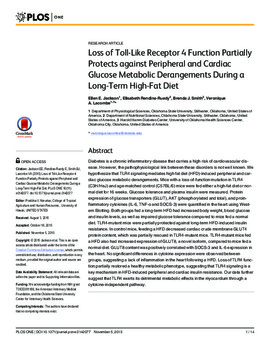| dc.contributor.author | Ellen E. Jackson | |
| dc.contributor.author | Elisabeth Rendina-Ruedy | |
| dc.contributor.author | Brenda J. Smith | |
| dc.contributor.author | Veronique A. Lacombe | |
| dc.date.accessioned | 2017-03-05T22:55:22Z | |
| dc.date.available | 2017-03-05T22:55:22Z | |
| dc.date.issued | 2015-11-05 | |
| dc.identifier.citation | Jackson EE, Rendina-Ruedy E, Smith BJ, Lacombe VA (2015) Loss of Toll-Like Receptor 4 Function Partially Protects against Peripheral and Cardiac Glucose Metabolic Derangements During a Long-Term High-Fat Diet. PLoS ONE 10(11): e0142077. doi:10.1371/journal.pone.0142077 | en_US |
| dc.identifier.uri | https://hdl.handle.net/11244/49281 | |
| dc.description | We would like to acknowledge Matt Priest for excellent technical assistance. | en_US |
| dc.description | | en_US |
| dc.description.abstract | Diabetes is a chronic inflammatory disease that carries a high risk of cardiovascular disease. However, the pathophysiological link between these disorders is not well known. We hypothesize that TLR4 signaling mediates high fat diet (HFD)-induced peripheral and cardiac glucose metabolic derangements. Mice with a loss-of-function mutation in TLR4 (C3H/HeJ) and age-matched control (C57BL/6) mice were fed either a high-fat diet or normal diet for 16 weeks. Glucose tolerance and plasma insulin were measured. Protein expression of glucose transporters (GLUT), AKT (phosphorylated and total), and proinflammatory cytokines (IL-6, TNF-α and SOCS-3) were quantified in the heart using Western Blotting. Both groups fed a long-term HFD had increased body weight, blood glucose and insulin levels, as well as impaired glucose tolerance compared to mice fed a normal diet. TLR4-mutant mice were partially protected against long-term HFD-induced insulin resistance. In control mice, feeding a HFD decreased cardiac crude membrane GLUT4 protein content, which was partially rescued in TLR4-mutant mice. TLR4-mutant mice fed a HFD also had increased expression of GLUT8, a novel isoform, compared to mice fed a normal diet. GLUT8 content was positively correlated with SOCS-3 and IL-6 expression in the heart. No significant differences in cytokine expression were observed between groups, suggesting a lack of inflammation in the heart following a HFD. Loss of TLR4 function partially restored a healthy metabolic phenotype, suggesting that TLR4 signaling is a key mechanism in HFD-induced peripheral and cardiac insulin resistance. Our data further suggest that TLR4 exerts its detrimental metabolic effects in the myocardium through a cytokine-independent pathway. | en_US |
| dc.language.iso | en_US | en_US |
| dc.publisher | PLos One | |
| dc.relation.ispartofseries | PLoS ONE 10(11): e0142077 | |
| dc.relation.uri | http://www.plosone.org/article/info%3Adoi%2F10.1371%2Fjournal.pone.0142077 | |
| dc.rights | Attribution 3.0 United States | |
| dc.rights.uri | https://creativecommons.org/licenses/by/3.0/us/ | |
| dc.subject | Heart,Diet,Insulin resistance,Glucose,Membrane proteins,Glucose signaling,Glucose metabolism,Toll-like receptors | en_US |
| dc.title | Loss of Toll-Like Receptor 4 Function Partially Protects against Peripheral and Cardiac Glucose Metabolic Derangements During a Long-Term High-Fat Diet | en_US |
| dc.type | Research Article | en_US |
| dc.description.peerreview | Yes | en_US |
| dc.description.peerreviewnotes | http://www.plosone.org/static/editorial#peer | en_US |
| dc.identifier.doi | 10.1371/journal.pone.0142077 | en_US |
| dc.rights.requestable | false | en_US |

